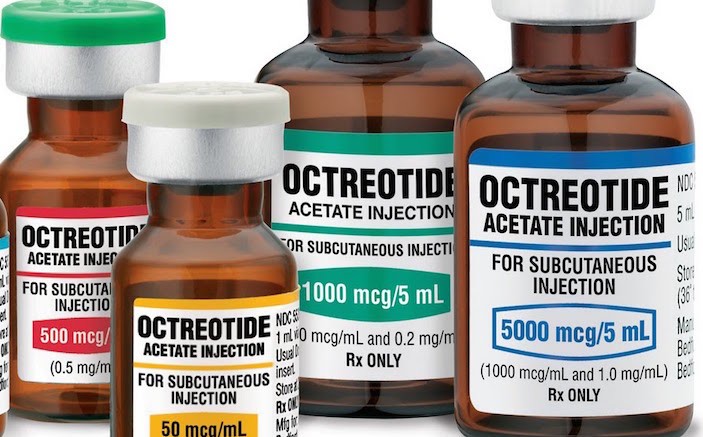This somatostatin analog is used “off-label” in the ED for variceal bleeds and sulfonylurea overdoses.
Octreotide is an octapeptide that mimics endogenous somatostatin. Somatostatin is released by cells in the pyloric antrum, the pancreas, and the duodenum. It has an overall inhibitory effect on secretion of multiple hormones, reducing gut motility and gastric emptying, and decreasing splanchnic blood flow. Octreotide contains the active moiety of somatostatin, and is several times more active than the endogenous hormone.
Major Indications
The major indications for octreotide use are not things we would treat in the ED. For example, it is used for chronic treatment of acromegaly, carcinoid tumor, and VIPomas. Its two major uses in the ED are, in fact, “off-label.”
Octreotide is frequently used in the ED for patients with a history of cirrhosis who present with a moderate or severe upper GI bleed presumed to be from a variceal source. Octreotide inhibits the release of glucagon, which is a splanchnic vasodilator. It therefore reduces splanchnic blood flow and portal venous pressure. The effect on portal pressure, however, is transient, lasting about five minutes even when used as an infusion [1], though it may continue to reduce intestinal blood flow for longer through other mechanisms [2]. The current therapy for acute variceal bleed typically involves octreotide in combination with sclerotherapy or band ligation, along with antibiotic prophylaxis [3]. Treatment with octreotide and sclerotherapy results in lower rates of re-bleeding than use of either therapy alone, though there was no improvement in mortality with the addition of octreotide [4]. A Cochrane review in 2008 systematically reviewed 21 trials with a total of 2,588 patients. They found no reduction in mortality with octreotide. They found the treatment group did have, on average, 0.7 fewer units of PRBCs transfused compared with patients who did not receive octreotide [5]. The authors of the Cochrane review conclude that: “It is doubtful whether this effect is worthwhile.” However, the risk of octreotide use is low, and it may provide a small benefit in reducing early re-bleeding. The treatment dose for variceal bleeds is with a 50 mcg IV bolus (range 25-100mcg), followed by 25-50 mcg/hr drip [6].
The other ED use for octreotide is in sulfonylurea overdose with hypoglycemia. Patients who present with sulfonylurea-induced hypoglycemia may initially respond to treatment with IV dextrose. However, the increase in blood sugar can then trigger insulin release, and cause worse rebound hypoglycemia from the increased insulin along with continued activity of the sulfonylurea, which both stimulates insulin release and also increases peripheral sensitivity to insulin. Octreotide inhibits the secretion of insulin, and can help prevent this recurrent hypoglycemia [7]. Treatment for this use is typically with 50-75 mcg SQ, which can be repeated every 6 hours if needed, and 1-2 mcg/kg SQ in children [8].
Notable History
Octreotide was first synthesized in 1979. Early studies touted its property as an antagonist of the opiate mu receptors [9]. It is currently not used in this manner, but has been used to treat diarrheal symptoms in patients withdrawing from opiates because of its anti-motility properties, as part of a multi-component rapid antagonist induction [10].
How It Works
Octreotide is an 8-amino acid peptide mimicking endogenous somatostatin. It has multiple interactions with other hormones, inhibiting the release of: glucagon, insulin, gastrin, vasoactive intestinal peptide (VIP), growth hormone, and insulin-like growth factor-1 and serotonin release [6].
Adverse Events and Safety
Most of the side effects of octreotide occur with prolonged use for its typical indications, as opposed to the off-label indications used in the ED. However, because of its effect on glucagon and insulin, it can cause hypoglycemia in patients with type I diabetes, and hyperglycemia in patients with type II or without diabetes [6]. It is pregnancy class B, with no adverse side effects noted in animal studies. It is secreted in breastmilk, but in small amounts that are unlikely to be absorbed in significant amounts by the infant [11]. However, if patients are receiving continuous dosing, they could “pump and dump” to prevent exposing the infant to the drug.
Dosing Adjustments
In older adults, the half-life for clearance is longer, so the lower range of the adult doses should be used. There are no renal or hepatic dosing adjustments listed, although its half-life is normally 1.7 to 1.9 hours, and is increased to 3.7 hours in patients with cirrhosis, and 3.1 hours in patients with renal impairment.
Cost
Generic octreotide solution used for IV or SQ injections is approximately $5 per 50mcg dose. The name brand, SandoSTATIN, is approximately three times the cost [6].
REFERENCES
- Bajaj JS, Sanyal AJ. Methods to achieve hemostasis in patients with acute variceal hemorrhage. UptoDate. 2015.
- Ludwig D, Schadel S, Bruning A, Schiefer B, Stange EF. 48-hour hemodynamic effects of octreotide on postprandial splanchnic hyperemia in patients with liver cirrhosis and portal hypertension: Double-blind, placebo-controlled study. Dig Dis Sci. 2000;45(5):1019-1027.
- Garbuzenko DV. Current approaches to the management of patients with liver cirrhosis who have acute esophageal variceal bleeding. Curr Med Res Opin. 2016:1-9.
- Banares R, Albillos A, Rincon D, et al. Endoscopic treatment versus endoscopic plus pharmacologic treatment for acute variceal bleeding: A meta-analysis. Hepatology. 2002;35(3):609-615. doi: ajhep0350609 [pii].
- Gotzsche PC, Hrobjartsson A. Somatostatin analogues for acute bleeding oesophageal varices. Cochrane Database Syst Rev. 2008;(3):CD000193. doi(3):CD000193.
- UptoDate.com – Lexicomp. Octreotide: Drug information. .
- Chi J, Stolbach A. Sulfonylurea agent poisoning. UptoDate. 2016.
- Howland MA, Smith SW. Antidotes in depth. In: Robert S. Hoffman, et al., ed. Goldfrank’s toxicologic emergencies. 10e ed. ; 2015. Accessed 1/21/2016.
- Maurer R, Gaehwiler BH, Buescher HH, Hill RC, Roemer D. Opiate antagonistic properties of an octapeptide somatostatin analog. Proc Natl Acad Sci USA. 1982;78(15):4815-4817.
- Carreno JE, Bobes J, Brewer C, et al. 24-hour opiate detoxification and antagonist induction at home– the ‘asturian method’: A report on 1368 procedures. Addict Biol. 2002;7(2):243-250.
- Hale TW. Medications and mothers’ milk: A manual of lactational pharmacology. 12th ed. Amarillo, TX: Hale Publishing L.P.; 2012:1331.



